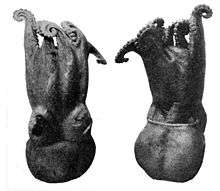Turquet's octopus
| Turquet's octopus | |
|---|---|
 | |
| Scientific classification | |
| Kingdom: | Animalia |
| Phylum: | Mollusca |
| Class: | Cephalopoda |
| Order: | Octopoda |
| Family: | Octopodidae |
| Genus: | Pareledone |
| Species: | P. turqueti |
| Binomial name | |
| Pareledone turqueti (Joubin, 1905) | |
| Synonyms | |
| |
Turquet's octopus (Pareledone turqueti) is a species of benthic octopus with a circumpolar Antarctic distribution. The species has a wide depth range, occurring from shallow waters to 4,000 m deep.[1]
P. turqueti grows to 15 cm in mantle length.[2] It is characterised by the absence of a skin ridge round the body, and its nearly smooth skin, which is covered with low granular bumps.[1]
In the wild, P. turqueti is known to be preyed upon by Patagonian toothfish off South Georgia[3] and Weddell seals off the South Shetland Islands.[4]
The type specimen was collected in the Antarctic Ocean (65°S, 64°W) and is deposited at the Muséum National d'Histoire Naturelle in Paris.[5]
References
- 1 2 Norman, M.D. 2000. Cephalopods: A World Guide. ConchBooks.
- ↑ CephBase: Mantle Length of Pareledone turqueti
- ↑ Xavier, J.C., P.G. Rodhouse, M.G. Purves, T.M. Daw, J. Arata & G.M. Pilling 2002. "Distribution of cephalopods recorded in the diet of the Patagonian toothfish (Dissostichus eleginoides) around South Georgia." (PDF). (159 KiB) Polar Biology 25: 323-330.
- ↑ Klages, N.T.W. 1996. "Cephalopods as prey. II. Seals." (PDF). (1.60 MiB) Phil. Trans. R. Soc. Lond. B 351: 1045-1052.
- ↑ Current Classification of Recent Cephalopoda
External links
- "CephBase: Turquet's octopus". Archived from the original on 2005.
- GenBank Links for Genetic Information on Pareledone turqueti
This article is issued from Wikipedia - version of the 11/17/2016. The text is available under the Creative Commons Attribution/Share Alike but additional terms may apply for the media files.